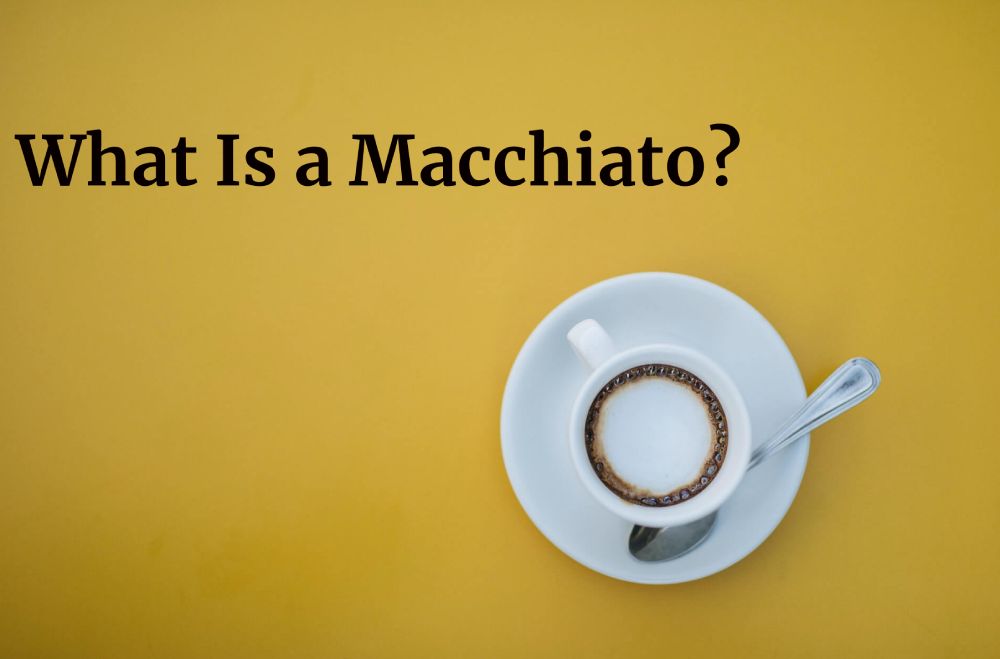Lattes, cappuccinos, cortados…Coffee shop menus can be difficult to read without a dictionary (and translator). Take a look at this guide to learn what a macchiato is.
There is a lot to choose from on the menu at your local coffee shop, even if it is a Starbucks. The first step to deciding what type of coffee drink you want is to decide what type of milk you want or whether you want your drink measured in Italian or ounces.
What’s the difference between lattes, cappuccinos, cortados, americanos, and cold brews? It’s no wonder the line moves so slowly. It is likely that you have heard a barista shout out a macchiato or maybe even a caramel macchiato. The macchiato is different from the other coffee drinks on the menu, but what is it?
Andreas Willhoff, co-author of Craft Coffee, director of education at Halfwit Coffee Roasters, and director of operations at The Wormhole, a Chicago-based craft coffee shop, knows. In this article, he explains everything you need to know about the macchiato, including how to order it at a cafe and how to make it at home.
Table of Contents
History of the macchiato
You might have guessed from the name that macchiatos originated in Italy. According to Willhoff, cappuccinos are consumed in the morning, while espresso and macchiatos are consumed in the afternoon. “Espresso is like drinking coffee black and macchiato is like adding a little cream.”
According to Willhoff, a traditional macchiato only contains two ingredients. “A macchiato is a shot of espresso topped with a small amount of foam,” he explains. According to Willhoff, macchiato means “stained” or “marked” in Italian. He explains that the foam is simply a way to mark the drink. It is common in Italy to make macchiatos with one shot of espresso and a small amount of foam, but in the United States most coffee shops use two shots of espresso instead of one.
What is a macchiato vs. latte vs. cappuccino?
You’re right, this drink sounds a lot like a cappuccino. According to Willhoff, cappuccinos are also made with espresso and foamed milk. Cappuccinos have more foam than lattes. Unlike a macchiato, which has just a spot of foam on top, a cappuccino has about 4 to 5 ounces of foam. Again, the difference between lattes and cappuccinos is in the ratio of the ingredients. Cappuccinos are equal parts espresso, steamed milk, and milk foam, lattes are primarily steamed milk with a shot of espresso, and macchiatos are primarily espresso with a small amount of steamed milk foam. Many cafes offer dairy-free macchiatos by substituting almond, oat, soy, or macadamia milk for cow’s milk in the 2020s.
Depending on where you order your macchiato, you may have the option of a cafe or espresso macchiato or a latte macchiato. “A cafe [or espresso] macchiato is a traditional version, while a latte macchiato is an American version you would find at Starbucks,” Willhoff explains. “[At Starbucks] they adhere to the ‘marked’ definition by pouring espresso over foamed milk instead of the other way around, so the espresso marks the milk.” In either case, a macchiato isn’t stirred, but it’s layered, with the milk foam resting on top.
The uber-popular caramel macchiato at Starbucks is a macchiato with caramel. The caramel is used to “mark” the top of the drink above the foam. The caramel macchiatos at Starbucks are actually lattes, which contains steamed milk in addition to espresso, and caramel syrup is incorporated into the drink as well as drizzled on top. Flavored macchiato drinks are offered by some cafes. Vanilla syrup is also added to Starbucks’ caramel latte macchiatos.
Is a macchiato stronger than a latte?
Due to the fact that a macchiato is primarily espresso, while a latte is primarily milk, a macchiato is considerably stronger than a latte. Additionally, it has more espresso than a cappuccino, making it stronger.
Of course, the strength of your macchiato is also determined by how many shots you order; the bigger the macchiato, the more espresso it has and the stronger it is. As long as the amount of espresso remains the same, adding a syrup (such as in a caramel macchiato) will not affect how strong your macchiato is. However, it will increase the calories.
Tips for ordering a macchiato
Having learned what a macchiato is, how can you order one at a cafe and be sure you’re getting exactly what you want? Here are a few tips Willhoff offers. You can order a macchiato with just espresso and foamed milk if you want a traditional macchiato. (Unless you want to specify the type of milk you would like.)
A One and One is what Willhoff prefers if you want to try something a little out of the ordinary. It’s a double shot of espresso split between two demitasses [small coffee cups used to serve espresso]. “One of them is served as is, and the other is turned into a macchiato. This is a fun way to compare espresso with and without milk.”
Your macchiato can be “marked” with a syrup, such as caramel or vanilla, to add a little sweetness. You can order this by saying “caramel macchiato” or “vanilla macchiato,” for instance.
How to make a macchiato at home
Willhoff suggests you need an espresso machine, grinder, and small milk pitcher to make your own macchiato (since you only need a small amount of milk, a 12-ounce pitcher should work). Espresso and milk will be needed next.
“Since the drink is mostly espresso, make sure you have some beans you like,” Willhoff says.
Willhoff recommends filling the pitcher about a centimeter below the spout when steaming milk for foam. In general, this is a good guideline.) Once your milk is steamed, put a spoonful of the foam on top of your espresso. (Different pitchers have slightly different spout geometry, but in general, this is a good guideline.) And that’s it!
The best way to order at a cafe or make your own macchiato is to order what you love, not what’s “traditional” or “right.” If you’re making something for yourself or a loved one, you can do whatever you want, but the coffee shop’s job is to appeal to as many people as possible.” he says. It doesn’t matter what you order, brew what you love and love what you brew.

